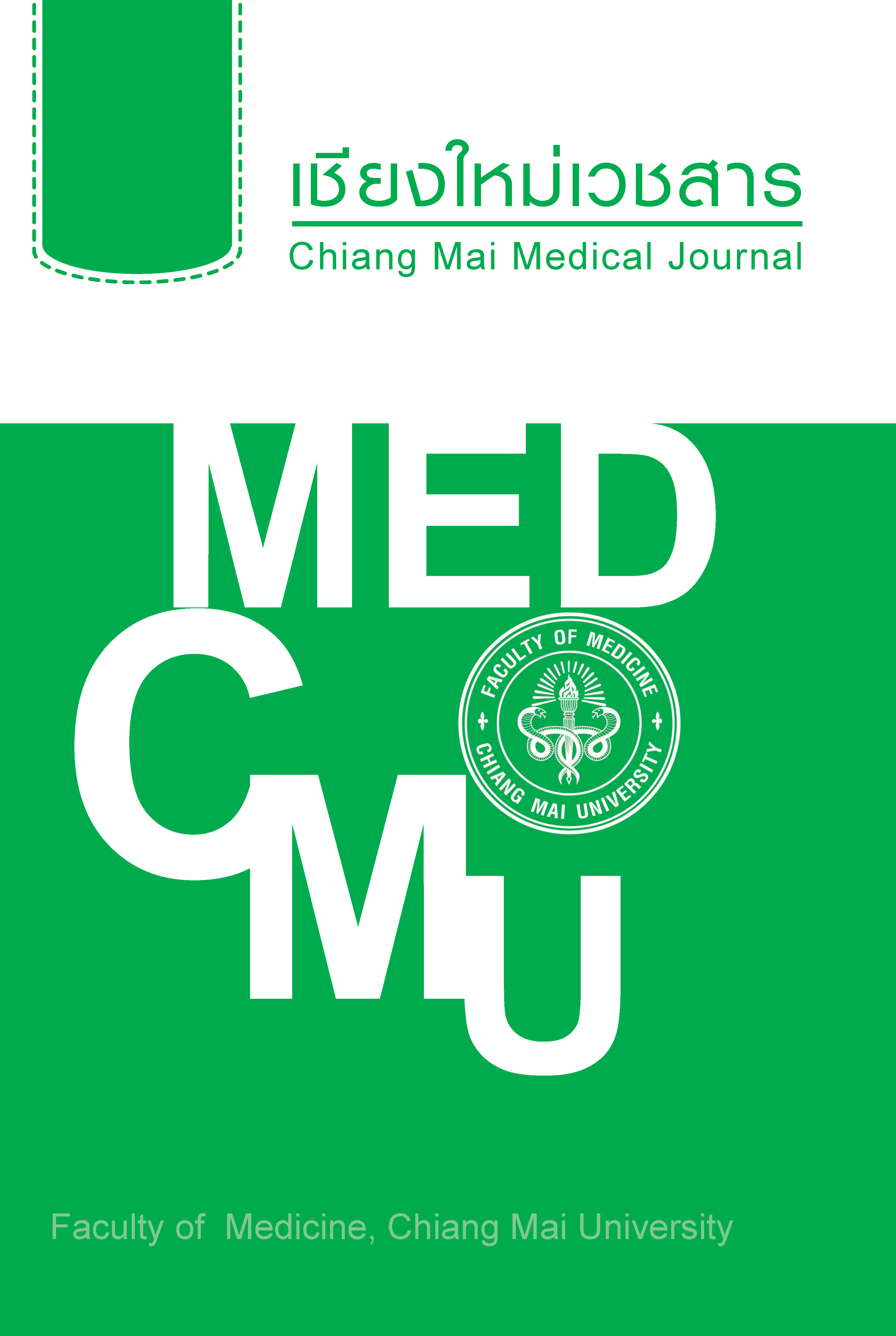The study of peripherally inserted central catheterizations in Neonatal Intensive Care Unit, Maharaj Nakorn Chiang Mai Hospital
Keywords:
peripherally inserted central catheter, neonate, neonatal intensive care unitAbstract
Objective To determine the clinical characteristics of newborns who had peripherally inserted central catheterizations (PICCs) and complication rates.
Methods This was a retrospective descriptive study of newborns who underwent PICCs placement on the neonatal intensive care unit at Maharaj Nakorn Chiang Mai Hospital form January 1, 2011 to December 31, 2015. Data from electronic medical records were compiled, including the demographic data, the PICCs insertion records and complications. Data were analyzed using descriptive statistics, incidence rates and binary logistic regression.
Results A total of 73 newborns with PICCs placements were analyzed. Sixty- nine (94.5%) newborns were less than 37 weeks gestational age; 46 (63.0%) were inserted PICCs at 1-10 days of age; 49 (67.1%) were very low birth weight infants (<1,500 grams), and 44 (60.3%) were inserted PICCs at body weight less than 1,500 grams. Forty-one newborns (56.2%) had duration of insertion for PICC less than 14 days, while 30 (41.1%) had administrated the total parenteral nutrition more than 30 days. Seventy-two (98.6%) used 1-French catheters. All the catheters were inserted into the antecubital vein. The most indications for PICCs placement were used for total parenteral nutrition (93.2%). The majority of PICCs were removed because no longer required (71.2%). PICCs complications occurred in 8 cases (10.9%). All of the complications were extravasations. The incidence rate of complications was found to be 7.1 per 1000 catheter days. The results revealed that body weight at PICCs insertion was a significant related to the PICCs complications. It indicatedthat body weight >1,500 gms is 11 times higher for PICCs complications than body weight < 1,500 gms (OR= 10.7, p=.01, 95% CI= 1.64-70.0).
Conclusion The results of this study provide baseline information in consideration of the provision PICCs placement, used to develop guidelines and management of PICCs in neonatal intensive care unit, especially in newborns weighing >1,500 gms at risk of extravasation.
References
Ng PK, Ault MJ, Maldonado LS. Peripherally inserted central catheters in the intensive care unit. J Intensive Care Med 1996;11:49-54.
Pettit J, Wyckoff MM. Peripherally inserted central catheters: guideline for practice. 2nd ed. Glenview, IL: National Association of Neo-natal Nurses; 2007.
Hoang V, Sills J, Chandler M, Busalani E, Clifton-Koeppel R, Modanlou HD. Percuta-neously inserted central catheter for total par-enteral nutrition in neonates: complications rates related to upper versus lower extremity insertion. Pediatrics 2008;121:e1152–9.
National Association of Vascular Access Networks. Tip location of peripherally inserted central catheters. J Vasc Access Devices 1998;3:8–10.
Johann DA, De Lazzari LSM, Pedrolo E, Min-gorance P, De Almeida TQR, Danski MTR. Peripherally inserted central catheter care in neonates: an integrative literature review. Rev Esc Enferm USP 2012;46:1502-10.
Sharpe E, Pettit J, Ellsbury DL. A national survey of neonatal peripherally inserted central catheter (PICC) practices. Adv Neonatal Care 2013;13:55-74.
Bulbul A, Okan F, Nuhoglu A. Percutaneous-ly inserted central catheters in the newborns: a center’s experience in Turkey. J Matern Fetal Neonatal Med 2010;23:529-35.
Infusion Nurses Society. Infusion nursing standards of practice. J Infus Nurs 2006;29:S1-92.
Haase R, Kunze C, Wludyka B, Thale V, Markel N. Malpositioning in blindly inserted PICCs in neonates: experience in 174 catheters. Arch Perinat Med 2010;16:187-93.
Pettit J. Assessment of the infant with a pe-ripheral intravenous device. Adv Neonatal Care 2003;3:230-40.
Hacking MB, Brown J, Chisholm DG. Posi-tion dependent ventricular tachycardia in two children with peripherally inserted cen-tral catheters (PICCs). Paediatr Anaesth 2003; 13:527-9.
Ohki Y, Yoshizawa Y, Watanabe M, Ku-washima M, Morikawa A. Complications of percutaneously inserted central venous cath-eters in Japanese neonates. Pediatr Int 2008; 50:636–9.
Allen AW, Megargell JL, Brown DB, et al. Ve-nous thrombosis associated with the place-ment of peripherally inserted central catheters. J Vasc Interv Radiol 2000;11:1039–14.
Costa P, Bueno M, AlvesAM, Kimura AF. In-cidence of nonelective removal of percuta-neously inserted central catheters according to tip position in neonates. J Obstet Gynecol Neonatal Nurs 2013;42:348-56.
Jain A, Deshpande P, Shah P. Peripherally inserted central catheter tip position and risk of associated complications in neonates. J Perinatol 2013;33:307-12.
Wrightson DD. Peripherally inserted central catheter complications in neonates with upper versus lower extremity insertion sites. Adv Neonatal Care 2013;13:198-204.
Ohki Y, Maruyama K, Harigaya A, Kohno M, Arakawa H. Complications of peripherally in-serted central venous catheter in Japanese neonatal intensive care units. Pediatr Int 2013; 55:185-9.
O’Hara MB, D’Angio C, Hoey H, Stevens TP. An evidence based catheter bundle alters central venous catheter strategy in newborn infant. J Pediatr 2012;160:972-7.
Singh A, Bajpai M, Pando SS, Jana M. Com-plication of peripherally inserted centeral venous catheters in neonates: Lesson learned over 2 year in a tertiary care centre in India. Afr J Paediatr Surg 2014;11:242-7.
Khan A, Wagner M. PICC line insertion and management in nicu. The children’s health network [Internet]; 2012 [cited 2017 Jan 11]. Available from: http://www.hnekidshealth.nsw.gov.au/site/content.cfm?page_id=351403¤t_category_code=8338&leca=930
Arnts IJ, Bullens LM, Groenewoud, JM, Liem KD. Comparison of complication rates between umbilical and peripherally inserted central venous catheters in newborns. J Obstet Gynecol Neonatal Nurs 2014; 43: 205-15.
Barria RM, Lorea P, Munoz S. Randomized controlled trial of vascular access in new-borns in the neonatal intensive care unit. J Obstet Gynecol Neonatal Nurs 2007;36:450-6.
Juve ME. Intravenous catheter decloting: Same outcomes with lower does urokinase. J Infus Nurs 2003;26:245-51.
Forauer AR, Alonzo M. Change in peripheral-ly inserted central catheter tip position with abduction and adduction of the upper ex-tremity. J Vasc Interv Radiol 2000; 11: 1315-8
Downloads
Published
How to Cite
Issue
Section
License
Copyright (c) 2017 เชียงใหม่เวชสาร (Chiang Mai Medical Journal)

This work is licensed under a Creative Commons Attribution 4.0 International License.








